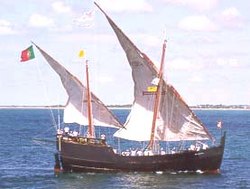Sailing ships
Early Middle Ages
Knarr

The knarr, a relative of the longship, was a type of cargo vessel used by the Vikings. It differed from the longship in that it was larger and relied almost entirely on its square-rigged sail for propulsion.
High Middle Ages
Cog

Cogs were single-masted vessels, with clinker-built sides and a flush-planked, flat bottom [1]
Although the name "cog" is recorded as early as the 9th century, [2] the seagoing vessel of that name seems to have evolved on the Frisian coast during the 14th century. [3] Cogs progressively replaced Viking-type ships in Northern waters during the 13th century. Why this was the case is uncertain but cogs could carry more cargo than knarr of a similar size. Their flat bottoms allowed them to settle flat in the harbor, making them easier to load and unload. Their high sides made them more difficult to board in a sea-fight, which may have made them safer from pirates. [4]
Cogs were also used as military transports and warships, fitted with towers fore and aft.
The cog traditionally reached the Mediterranean in 1304. This led to a Mediterranean variant, the coach. [5]
Hulk
The hulk (OE: hulc) is first recorded in the 10th century, when it is distinguished from a keel (OE: ceol), a ship in the Nordic tradition such as the knarr. Very little is known about the hulc, with no archaeological remains or usefully descriptive contemporary records. Early images of hulks show them strongly curved upwards at stem and stern. [6]
Hulks continued to be mentioned in use throughout the Middle Ages and into the 16th century when it is particularly associated with the Baltic and the Hanseatic League. These late hulks could be as large as contemporary great ships. Jesus of Lübeck of 1544 was a ship of 700 long tons (780 short tons; 710 t), the same as the Mary Rose . [7] However, how similar later medieval hulks were to their ancestors is unknown. There is some evidence of hybridization with the cog form, showing both hulk and post-construction. [8] Others have suggested that late hulks were partially carvel-built. [9]
Late Middle Ages
Caravel

The caravel was a ship developed by the Portuguese in the 13th century, being used for fishing and cargo work. It was well suited to some of the exploration activity in the Age of Discovery and was used from about 1440 in this activity. Unlike the longship and cog, it used a carvel method of construction. In contrast to some contemporary Mediterranean ship types, caravels had a rudder mounted on the sternpost, as opposed to using a side-mounted steering oar. It could be either square rigged and lateen rigged (Caravela Redonda) or only lateen rigged (Caravela Latina), as is found in earlier examples. The most famous examples of caravels were the Niña and the Pinta . [10] The caravel became increasingly common in Northern European waters from the 1430s and the spread of this one type of vessel meant that carvel construction had to be learnt in the shipyards outside the Iberia. [11] [10]
Carrack

The carrack was a ship type invented in southern Europe in the 15th century and particularly developed in Portugal in the same century. It was a larger vessel than the caravel. Columbus's flagship, the Santa María , was a famous example of a carrack. The ships commanded by Vasco da Gama as the São Gabriel, with six sails, a bowsprit, foresail, mizzen, spritsail and two topsails, already had the complete features and the design of the typical carrack.
An example of a Northern European late medieval vessel with many characteristics of a carrack is the Danish-Norwegian flagship of King Hans, Gribshunden, which sank off modern-day Sweden in June 1495. It was probably built in the Low Countries near modern-day Rotterdam in 1485, from timber cut in the River Meuse watershed of the Ardennes forest. Archaeological excavation shows its carvel-built hull carried three masts, and featured a forecastle and lapstrake stern castle. With a keel length of about 25.5 meters and an overall length in excess of 30 meters, it was a large ship for the time, especially in the Baltic Sea. It served not only as a warship armed with as many as 68 artillery pieces, but as a mobile castle to serve all of the king's needs as he traveled throughout his realm. [12] [13] [14] [15]
Small vessels
A number of smaller vessels are named in English sources of the Late Middle Ages, some of which continued into the 16th century and beyond.
Crayer
A vessel of 20-50 tons, used largely on the cross-channel trade. [16]
Hoy
The hoy originated in Flanders in the 15th century. A single-masted vessel usually of 25–80 long tons (28–90 short tons; 25–81 t) used a coaster or on short sea routes, as well as a lighter. The type would evolve in the 16th and 17th, only finally disappearing in the early 19th century. [17]
Picard
First recorded in the 1320s, the picard was a single-masted vessel of 10–40 tons used mainly as support vessel for fishing fleets, bringing home their catches and ferrying supplies, or as a lighter, loading from vessels at anchor and discharging onto beaches or shallow creeks. A widespread type, in use from Scotland, all round the English coast and across in Ireland. [18]